Navigation
Install the app
How to install the app on iOS
Follow along with the video below to see how to install our site as a web app on your home screen.

Note: This feature currently requires accessing the site using the built-in Safari browser.
More options
You are using an out of date browser. It may not display this or other websites correctly.
You should upgrade or use an alternative browser.
You should upgrade or use an alternative browser.
Dinosaur tracks
- Thread starter J.E.D
- Start date
possum hidin' under the couch `cause Uncle Ferd tol' him dat dinosaur gonna get him...

Death of the Dinosaurs: New Proof of Asteroid or Meteor Impact
Feb. 7, 2013 - Go digging with dinosaur hunters and they will show you that the last of the Cretaceous beasts died out suddenly, 66 million years ago. For 30 years the prevailing theory has been that T. rex and its brethren were wiped out by a comet or asteroid crashing in Central America, kicking up so much dust and ash that the Earth cooled for years afterward and made survival impossible.
Death of the Dinosaurs: New Proof of Asteroid or Meteor Impact
Feb. 7, 2013 - Go digging with dinosaur hunters and they will show you that the last of the Cretaceous beasts died out suddenly, 66 million years ago. For 30 years the prevailing theory has been that T. rex and its brethren were wiped out by a comet or asteroid crashing in Central America, kicking up so much dust and ash that the Earth cooled for years afterward and made survival impossible.
Or was it really that simple? Some scientists, digging into well-preserved layers of the earth, said the timing was off. Yes, there is a 110-mile-wide crater, called Chicxulub, in the Caribbean off the coast of southern Mexico -- but radioactive dating suggested it was made 180,000 years after the last dinosaur fossils. Something was wrong. So Paul Renne, an earth scientist at the University of California, Berkeley, decided to test the theory. Today he and his team report in the journal Science that the death-from-the-sky theory holds up after all. The great impact happened 66,038,000 years ago -- within 30,000 years of the dinosaurs' extinction. When you're talking about things that happened tens of millions of years ago, that's pretty good. "I wouldn't say the theory was in trouble, but there have been skeptics and the absolute timing has never quite lined up," said Renne in an email to ABC News.
He and his team took earth samples from a formation in Montana called Hell Creek -- a remote place that is heaven to paleontologists because fossils and soil, left over the eons, are well preserved there. When the Chicxulub impact occurred, it deposited a very thin layer of ash whose age can be measured by the decay of a radioactive isotope of potassium. They combined it with other measurements to confirm the date of the so-called KT boundary -- when the period of the Cretaceous dinosaurs ended.
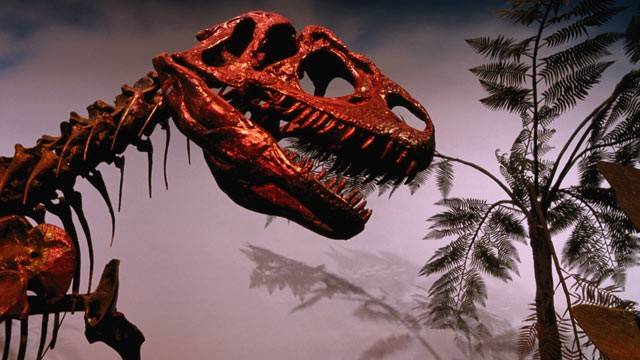
A dinosaur skeleton at the Royal Ontario Museum in Canada.
Not all dinosaurs were killed off, you'll recall. Some of their descendants survive today as birds. And there were small mammals that thrived once they were out of the way. A separate paper in the same edition of Science describes a small insect-eating animal, a bit like a modern shrew, that appeared about 65 million years ago -- not long after the dinosaurs disappeared. Why, beyond fascination with the past, is the Chicxulub catastrophe worth studying? Because it was not the first time much of the life on Earth was wiped out, and it may not be the last. Astronomers have been keeping an eye out for asteroids that could, in future years, be on a crash course with us. There's a small asteroid called 2012 DA14 that will come within 17,200 miles of Earth this month.
Renne and other scientists say the dinosaurs were probably already struggling by the time of the great impact, but today's paper shows that something catastrophic happened right around the time scientists find the last fossils of great dinosaurs. It's been estimated that 70 percent of all species disappeared in fairly short order. "It's possible that the impact was enough, but there is ample evidence that other things such as rapid climate swings were going on just beforehand, so it seems likely that the impact tipped the balance of an already-stressed biosphere," Renne said. "I've always felt that we should avoid simply saying, 'OK, Eureka, it was an impact and now we're done' -- simple answers are often incomplete."
Source
New dinosaur found in Utah...

New Horned Dinosaur Unearthed
July 18, 2013 > A new species of horned dinosaur has been unearthed in Grand Staircase Escalante National Monument in the high rugged desert of southern Utah. Nasutoceratops - which means big-nosed horn face - lived 76 million years ago, in the late Cretaceous period, in what was then a subtropical swampy environment.

New Horned Dinosaur Unearthed
July 18, 2013 > A new species of horned dinosaur has been unearthed in Grand Staircase Escalante National Monument in the high rugged desert of southern Utah. Nasutoceratops - which means big-nosed horn face - lived 76 million years ago, in the late Cretaceous period, in what was then a subtropical swampy environment.
Scott Sampson, chief curator with the Natural History Museum at the University of Utah, led the excavation that found what appears to be a new branch of the horned dinosaur family tree. He said Nasutoceratops' skull has a significantly different set of horns than its well-known cousin, Triceratops. Its unique in having this tiny little horn over the nose and then these big long horns over the eyes, which is very different from the closest relative, within that group of horned dinosaurs," he said.
The four-legged herbivore measured about five meters from head to tail and weighed about 2.5 tons. Sampson said the discovery includes a nearly complete skull, 1.5 meters long, and pieces of two or three other skulls. With that mostly complete skull there is a neck and part of the back, that is the vertebrae in the backbone," he said. "We also have a forelimb shoulder and forelimb all the way down to the foot on that one animal. So, were missing the back end of Nasutoceratops right now.
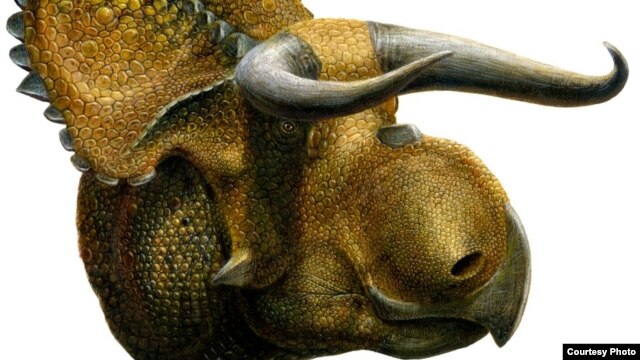
Artist rendition of Nasutoceratops, which lived in a swampy, subtropical setting on the island continent of western North America, known as Laramidia.
The vast 800,000-hectare Grand Staircase- Escalante National Monument is the last great dinosaur boneyard in the United States. For most of the Late Cretaceous period, a warm, shallow sea extended from what is now the Arctic Ocean to the Gulf of Mexico, subdividing North American into eastern and western landmasses, known as Appalachia and Laramidia, respectively. Laramidia was the same size as current day Australia. Beginning in the 1960s, paleontologists began to notice the same major groups of dinosaurs over Laramidia, but different species of these groups occurred in the north and south. Nasutoceratops will be on permanent display at the Natural History Museum of Utah. The discovery was announced in the British scientific journal, "Proceedings of the Royal Society B."
New Horned Dinosaur Unearthed
Mebbe `gators an' snappin' turtles are dinosaur descendants?...
Dinosaur Descendants Shrank to Survive
May 06, 2014 ~ Not all dinosaurs went extinct. Some are alive today in the form of birds. A new study finds that shrinking helped these birds continue to thrive and evolve.
Dinosaur Descendants Shrank to Survive
May 06, 2014 ~ Not all dinosaurs went extinct. Some are alive today in the form of birds. A new study finds that shrinking helped these birds continue to thrive and evolve.
If we really want to know how birds came about, then we need to study the line leading to birds, which includes this big diversity of animals like triceratops and stegosaurus and T. Rex, said Roger Benson, associate professor of paleontology at Oxford University and lead author of the study reported PLOS Biology. His team followed the evolution more than 400 dinosaurs, noting their size and what they weighed. The largest dinosaur in our study we believed weighed 90 tons, and the smallest dinosaur was a bird called Qiliania and that weighed 15 grams," Benson said. "So you could fit Qiliania six million times inside Argentinosaurus, the largest dinosaur.
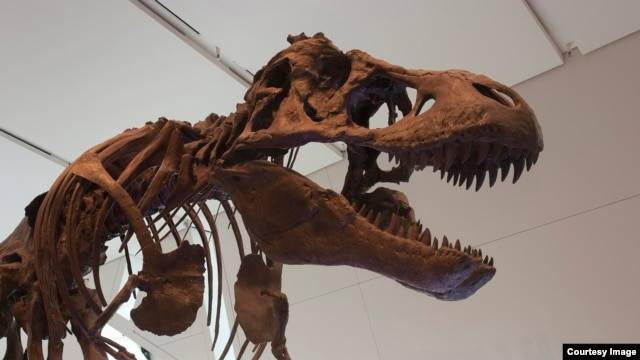
Tyrannosaurus rex went extinct in a relatively short compared to the dinosaur line that led to birds.
Since these species are extinct, Benson's team calculated that weight with an analysis of fossil limbs which, like pillars, would hold up the weight of the dinosaur. And theres a welcome strained relationship between the robustness of those pillars and the mass of the animal that is observed among modern mammals and reptiles, and so its fairly reliable for knowing the masses of extinct animals, he said. The study examined how fast body size changed on the entire family tree of dinosaurs, based on the thickness of their thigh bones. It found dinosaurs quickly evolved big bodies, soon after their origins about 220 million years ago.
Then the rates of growth slowed and these giants went extinct after 20 million years. Benson says the one exception was the line leading to birds, which kept evolving a range of body mass, including radically smaller body sizes. We find that fast rates of evolution are maintained for the whole study period, so for nearly 200 million years," Benson said. "So this is a very evolvable lineage. Theres a long ancient background to the modern radiation [spread] of birds through which their ancestors were constantly finding new ecological opportunities and inventing new ways of being an organism.
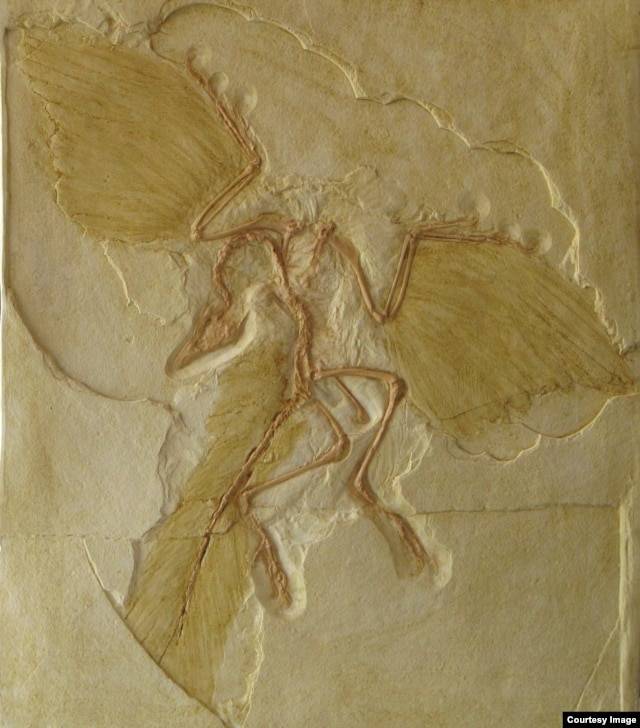
The lightweight Archaeopteryx is considered the first bird. Its shrinking size might have been key to the evolutionary success of birds.
He says the long journey evident in the fossil record that connects the 10,000 bird species alive today underscores a bigger evolutionary question. We're no longer asking how the radiation of living birds proceeded over, let's say, 100 million years," he said. "Instead we're asking where does biological diversity come from over very long time scales and ultimately those time scales might be relevant in establishing how life evolved in general, not just birds or just even vertebrates, but just organisms or animals in general? Benson says what is clear from this study is that evolving different sizes was important to the success of the feathered dinosaur lineage. His next step is to look at other patterns in dinosaur evolution to see how other features changed over time.
Dinosaur Descendants Shrank to Survive
possum hidin' under the couch `cause Uncle Ferd told him there's one outside waitin' to scoop him up...
Ancient Flying Reptile Named After 'Avatar' Creature
September 12, 2014 WASHINGTON — Some of the most visually stunning sequences from director James Cameron's blockbuster movie “Avatar” involved graceful flying creatures that were ridden by blue human-like beings facing ecological destruction on a moon called Pandora.
Ancient Flying Reptile Named After 'Avatar' Creature
September 12, 2014 WASHINGTON — Some of the most visually stunning sequences from director James Cameron's blockbuster movie “Avatar” involved graceful flying creatures that were ridden by blue human-like beings facing ecological destruction on a moon called Pandora.
It turns out that an animal very similar to those “Avatar” creatures, called Ikran, actually did exist here on Earth long ago. Scientists on Thursday announced the discovery of fossils in China of a new species of flying reptile called a pterosaur that lived 120 millions years ago and so closely resembled the creatures from the 2009 film that they named it after them. It is called Ikrandraci avatar, meaning “Ikran dragon” from “Avatar.” And this pterosaur is noteworthy for more than just its resemblance to a movie creature.
Throat pouch
The scientists said it appears that Ikrandraci avatar had a throat pouch similar to that of a pelican. It probably fed on small fish from freshwater lakes, flying low over the water and catching prey by skimming its lower jaw into the water, they said. It may have stored the fish in the pouch, they added. This Cretaceous Period pterosaur boasted an unusual blade-like crest on its lower jaw like the one on the movie creatures. “The head structure is similar in this pterosaur to the Ikran in 'Avatar,”' said one of the researchers, paleontologist Xiaolin Wang of the Institute of Vertebrate Paleontology and Paleoanthropology, Chinese Academy of Sciences in Beijing. “Of course, nobody and nothing can ride this pterosaur,” Wang added.
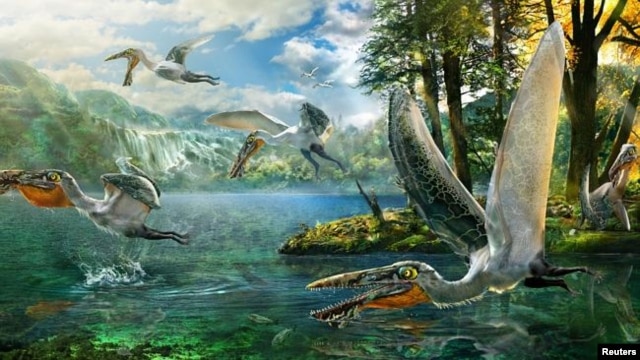
The ecological reconstruction of Ikrandraco avatar is shown in this handout illustration.
Another of the researchers, paleontologist Alexander Kellner of Brazil's National Museum at the Federal University of Rio de Janeiro, joked: “Please, [there were] no blue hominids during the Cretaceous.” Ikrandraci avatar, whose fossils were unearthed in China's Liaoning province, boasted a wingspan of about eight feet (2.5 meters), Kellner said.
Flying vertebrates
It did not have a crest on the top of its elongated head as many pterosaurs did. Behind the lower jaw crest was a hook-like structure that appears to have been the anchor point for the throat pouch, Kellner said. It had relatively small teeth good for snaring small fish. It lived in a warm region teeming with life, with feathered dinosaurs, birds, mammals, frogs, turtles and other animals along with a variety of trees and other plants, Wang said.
The researchers studied fossils of two specimens of Ikrandraci avatar. Pterosaurs were Earth's first flying vertebrates, with birds and bats making their appearances later. They thrived from about 220 million years ago to 65 million years ago, when they were wiped out by the asteroid that also doomed the dinosaurs. The study was published in the journal Scientific Reports.
Ancient Flying Reptile Named After Avatar Creature
Mr. H.
Diamond Member
Amazing what God has done in 6,000 years, huh.
Aktas
Active Member
- Apr 11, 2015
- 136
- 8
- 31
Wow..New dinosaur found in Utah...
New Horned Dinosaur Unearthed
July 18, 2013 > A new species of horned dinosaur has been unearthed in Grand Staircase Escalante National Monument in the high rugged desert of southern Utah. Nasutoceratops - which means big-nosed horn face - lived 76 million years ago, in the late Cretaceous period, in what was then a subtropical swampy environment.
Scott Sampson, chief curator with the Natural History Museum at the University of Utah, led the excavation that found what appears to be a new branch of the horned dinosaur family tree. He said Nasutoceratops' skull has a significantly different set of horns than its well-known cousin, Triceratops. Its unique in having this tiny little horn over the nose and then these big long horns over the eyes, which is very different from the closest relative, within that group of horned dinosaurs," he said.
The four-legged herbivore measured about five meters from head to tail and weighed about 2.5 tons. Sampson said the discovery includes a nearly complete skull, 1.5 meters long, and pieces of two or three other skulls. With that mostly complete skull there is a neck and part of the back, that is the vertebrae in the backbone," he said. "We also have a forelimb shoulder and forelimb all the way down to the foot on that one animal. So, were missing the back end of Nasutoceratops right now.

Artist rendition of Nasutoceratops, which lived in a swampy, subtropical setting on the island continent of western North America, known as Laramidia.
The vast 800,000-hectare Grand Staircase- Escalante National Monument is the last great dinosaur boneyard in the United States. For most of the Late Cretaceous period, a warm, shallow sea extended from what is now the Arctic Ocean to the Gulf of Mexico, subdividing North American into eastern and western landmasses, known as Appalachia and Laramidia, respectively. Laramidia was the same size as current day Australia. Beginning in the 1960s, paleontologists began to notice the same major groups of dinosaurs over Laramidia, but different species of these groups occurred in the north and south. Nasutoceratops will be on permanent display at the Natural History Museum of Utah. The discovery was announced in the British scientific journal, "Proceedings of the Royal Society B."
New Horned Dinosaur Unearthed
R
rdean
Guest
The right wing argument is if you can find pictures of Jesus everywhere, you can piece together a so called dinosaur from rock formations.Amazing what God has done in 6,000 years, huh.

Mr. H.
Diamond Member
This is no time for selfies, man. Geez.The right wing argument is if you can find pictures of Jesus everywhere, you can piece together a so called dinosaur from rock formations.Amazing what God has done in 6,000 years, huh.

JBvM
VIP Member
Miss that sense of humorAmazing what God has done in 6,000 years, huh.
Similar threads
- Replies
- 38
- Views
- 386
- Replies
- 4
- Views
- 75
Latest Discussions
- Replies
- 103
- Views
- 638
- Replies
- 239
- Views
- 894
- Replies
- 206
- Views
- 1K
Forum List
-
-
-
-
-
Political Satire 8008
-
-
-
-
-
-
-
-
-
-
-
-
-
-
-
-
-
-
-
ObamaCare 781
-
-
-
-
-
-
-
-
-
-
-
Member Usernotes 466
-
-
-
-
-
-
-
-
-
-



